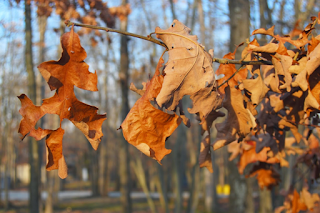 |
| POMEGRANATE (Photo:Ivar Leidus, CC BY-SA 4.0 Wikimedia Commons) |
For many, the first
meal of the new year is a very important one while for others there are a
variety of traditions. They generate
wishes for the new year to bring hope, riches, and travel. Or they may be just
a celebration of light at this seasonal time of year.
PORK & SAUERKRAUT
A Pennsylvania Dutch tradition is pork and sauerkraut on New Year's Day to have good luck and growth in the new year. Pigs (pork) represent progress and forward movement as they root forward unlike other animals who scratch backward. Sauerkraut, made from round, green cabbage, may represent money while the long pieces of sauerkraut suggest a long life.
FIREWORKS & OLIEBOLLEN
In the Netherlands,
like almost everywhere across the world, fireworks and explosions are a
highlight. There is a traditional treat, oliebollen, that mimics the Faschnacts
that show up on Shrove Tuesday in Pennsylvania. These are “oil cakes” or small
bite-sized fried dough balls dipped in powdered sugar.
BLACK-EYED PEAS &
COLLARDS
A U.S. Southern tradition, eating black-eyed peas and collard greens on New Year's Day, will bring good luck and prosperity. The peas carry good luck while the collards, being green, may bring money. One tradition common in the United States is that each person at the meal should leave three peas on their plate to ensure that the New Year will be filled with luck, fortune and romance.
Hoppin' John is a
recipe that features black-eyed peas, and is now a favorite staple of Southern
food. If, after the New Year's Day meal, you have leftovers they are called
Skippin' Jenny.
GRAPES
In Spain eating 12
grapes during the last minutes before the New Year begins brings good luck. Eat
one on each of the chimes at midnight.
ONIONS, POMEGRANATES
& CAKE
In Greece hanging an
onion outside the door signals prosperity, good luck, abundance, and rebirth.
On New Year’s Day, parents may wake children by tapping them on the head with
the onion. Breaking a pomegranate also brings luck, the more scattered seeds,
the more prosperity.
Another customary Greek tradition is consuming Vasilopita, or Saint Basil’s cake. This cake is baked with a silver or gold coin inside, and whoever finds the coin in their slice is considered especially lucky in the coming year.
SMUDGING
The word smudge
comes from the Middle English
word smogen -to smother with smoke. For thousands of years, recorded back to the days of the
pharaohs in Egypt, smoke from burning materials has been used for a variety of
spiritual, ceremonial, medicinal purposes, and cleansing. During the rise of the New Age culture during the 1970's and '80's, the Native American practice of smudging was appropriated for various uses and celebrations. Smudging a space,
usually a home, on New Year’s Day is thought to cleanse the area of any bad
spirits and negativity and prepare a place for the new year to start fresh.
Most often white sage is used but other herbs can be added or used separately.
HOGMANAY & “FIRST-
FOOTING”
In Scotland, New Year’s
Eve is a big night celebrating the winter solstice as well as the beginning of the
new year. There are the usual bonfires, torches, and fireworks.
There are Hogmanay is
what we Scots call New Year's Eve - 31 December - the big night that marks the
arrival of the new year. Its origins reach back to the celebration of the
winter solstice among the Vikings with wild parties in late December.
Many festivals and
celebrations include torches and bonfires celebrating the return of seasonal
light. At midnight it is traditional to sing “Auld Lang Syne”.
One of the unique traditions is known as “first-footing.” The first person to cross the threshold should bring a gift of luck. According to the custom, the first person who crosses the threshold of a person’s home should bring a gift of luck. Traditionally, this gift was a coal for the fire or This was traditionally a piece of coal to wish for warmth but has widened out to include the addition shortbread to wish for food, a silver coin for wealth, and a bit of whiskey for good cheer.
MISTLETOE
In Ireland, it's
customary for single gals to put mistletoe under their pillows on New Year’s
Eve to dream of their future husbands. Many cultures have picked up the
practice of hanging mistletoe encouraging love and kisses.
SUITCASES, MONEY &
LENTILS
In Columbia, the
traditions stand for wishes – for fortune, prosperity, travel and, of course,
luck. Partygoers may arrive with empty suitcases looking for the coming year to
include travel while others carry money in their pockets to bring prosperity.
Maybe originating in
Europe, carrying lentils in your pockets is supposed to symbolize a prosperous
new year.
WHITE FLOWERS In Rio de Janeiro, New Year's Eve revellers wear white and throw white flowers into the sea as part of Festa de Iemanjá, the goddess of the sea.
NEW YEAR'S PLANT GIFT
No doubt started by the horticultural industry, giving a plant as a gift is for the New Year may be a living symbol of good tidings and fresh beginnings. It isn’t any one species of plant. The recipient would most likely appreciate something unusual. It should be something that stands apart from the ordinary.
WHAT PLANT WOULD YOU GIVE AS A NEW YEAR GIFT & WHY?
* * * * *
Check out the Herb Sampler on this Blog
SPECIAL Price reduction on this 5 * * * * * book
























